
If you ever play for family or friends…I’m willing to bet you often get asked about your guitar capo…
What is that thing?
And why do you move it after each song?
For some reason, people who don’t play guitar are endlessly fascinated by it…
Yet most of us who do, think they’re all the same.
But if you’ve owned multiple capos, then you understand the difference a good one can make.
And you know how a bad one requires constant re-adjusting, and becomes an endless distraction from what you should be focussing on…your playing.
And so…for today’s post I’ve created a comprehensive guide covering the various styles of guitar capos and how they compare.
First up…
1. Trigger Guitar Capos

Probably the most popular of all designs…
Trigger capos work using a spring-loaded clamp to hold their tension.
With this design, players can quickly and easily reposition the capo using just one hand.
However…
The common complaint about this design is that the tension is non-adjustable.
Which means…
- if it’s too weak, you have problems with fret-buzz.
- if it’s too strong, you have problems with tuning from over-bending the strings.
But despite these potential problems, trigger capos are cheap, easy-to-use…and make an excellent “first guitar capo” for beginners.
Here are the top models I recommend:
- Dunlop 83CB – (Amazon/Sweetwater/Thomann)
- Kyser KG6B – (Amazon/Sweetwater/Thomann)
- D’Addario Tri-Action – (Amazon/Sweetwater/Thomann)
Up next…
2. Screw Guitar Capos
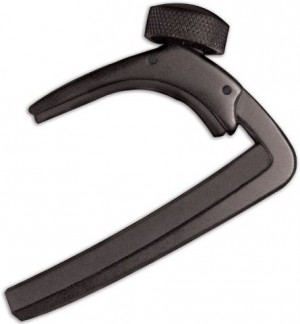
To address the potential problems of trigger capos…
Screw capos work using an adjustable mechanism that allows you to fine-tune its pressure against the strings.
This allows you to dial-in the perfect tension regardless of:
- neck size
- fret position
- string action
…or any other variable you might encounter.
But despite the enormous advantage, this design has its own flaws as well.
Repositioning takes far more time, because each time you move it, you must loosen the tension, and tighten it back up over its new position. On-stage, this can lead to poorly set tensions, and awkward breaks in a performance.
However despite this shortcoming, screw capos are still a favorite among many guitar players.
Currently, these are the top ones I recommend:
- D’Addario NS – (Amazon/Sweetwater/Thomann)
- Hamilton Capo – (Amazon)
- Paige P6E – (Amazon/Sweetwater)
Up next…
3. Roller Guitar Capos
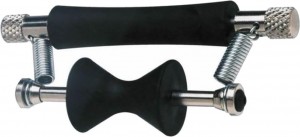
While probably the least popular of all the capo designs on this list…
Roller capos still receive praise from a select few guitar players who only swear by it.
Major advantages of this design include:
- fast repositioning – you just slide it up and down the neck.
- effortless removal – you just slide it over the nut for open-string playing.
- wider fretting pressure – so there are less issues with tuning.
The disadvantages are:
- Non-adjustable tension – which can potentially cause the same problems as trigger capos
- Lots of metal surface – which has the potential to scratch your guitar
- Limited neck size – which may not fit classical and 12-string guitars
While it wouldn’t be my first choice for beginners, you never really know if you’ll like this design until you try it.
The top model I recommend is:
- Glider GL-1 – (Amazon)
Up next…
4. Toggle Capos
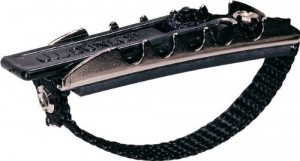
The simplest of all designs on this list…
The toggle capo holds its tension with an adjustable strap…
Which is incrementally tightened along several notches on the back of the bar.
Many players (including myself), love them because they are so small and light…you barely even notice them as you play.
Yet despite this one HUGE advantage, they’re the most problematic design overall.
And here’s why:
When securing it over the neck, the ideal strap tension often lies somewhere in-between two notches. One notch is too loose, and the next is too tight.
And even if it’s perfect, the strap will still stretch and loosen over time.
To solve this problem, one simple trick I’ve discovered is to add a half-twist to the strap as necessary to slightly shorten its length.
Of course, this continuous stretching eventually will cause breakage. But oh well…they’re super cheap anyway.
Currently these are the two models I recommend:
- Dunlop Elastic – (Amazon/Thomann)
- Dunlop Toggle – (Amazon/Sweetwater/Thomann)
Up next…
5. Shubb Capos
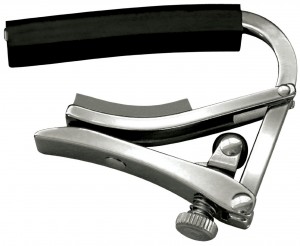
To solve many of the common problems of traditional guitar capos…
A revolutionary new design known as the Shubb C1 was developed back in 1980.
Through the use of a simple lever, which could be adjusted for tension, and easily flipped on or off…
The Shubb capo design combined both the speed of a trigger capo, with the precision of a screw capo.
And its unique rubber contact surface prevented tuning problems by providing a broader fretting surface mimicking a real human finger.
Over the years, the Shubb company continually refined their design, making several capos designed for specific instruments and playing styles.
While they’re significantly more expensive than the previous capos we’ve seen…users will tell you that they’re well-worth the added cost.
Here is an assortment of their most popular models:
- Standard Acoustic – (Amazon/Sweetwater/Thomann)
- Deluxe Acoustic – (Amazon/Sweetwater/Thomann)
Up next…
6. G7th Capos
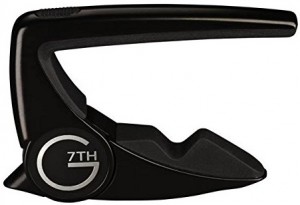
While the Shubb company offered some incredible advancements in capo technology…
They were eventually outshined by a new company which launched in 2004, known simply as G7th.
Just like Shubb capos, G7th capos offer convenient solutions to all the major problems associated with earlier capo designs.
- They’re unobtrusive on your playing – because they have no awkward bars or levers that get in your way.
- They’re gentle on your guitar – because the outside has no sharp metal edges, and the inside is lined entirely with rubber.
- They allow for easy fine-tension adjustment – because all you need to do is squeeze it down over the desired location, and it automatically locks in place.
- They’re easy to move – because all you do to release it is flip the lever.
And as many reviews claim…they’re also somehow better at preserving tone, which is arguably the greatest benefit of all.
Besides being heavier than some people prefer, G7th capos are damn-near flawless. So if you’re looking for a top-of-the-line guitar capo, it’s the obvious choice.
Here are their current models:
- G7th Newport – (Amazon/Sweetwater/Thomann)
- G7th Performance 2 – (Amazon/Sweetwater)
- G7th Classical – (Amazon/Sweetwater/Thomann)
And finally…
7. Partial Capos
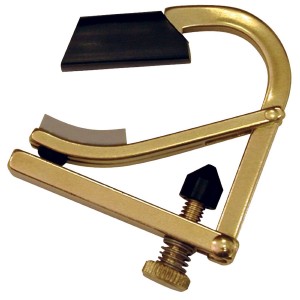
While 99 percent of guitar players will never use them…
There’s a tiny subset of experimental musicians who occasionally use partial capos…
To create sounds not normally possible on a standard guitar.
For players who enjoy open tunings, they offer a great way to exponentially increase the possibilities when creating new chords and drone combinations.
And while you might call them a specialty tool reserved only for the ultra-advanced…there’s no reason they can’t be a fun tool for everyday players to simply play around with.
So if you’re interested in trying one, here are the models I recommend:
- Shubb GC-PB – (Amazon/Sweetwater/Thomann)
- Kyser Shortcut – (Amazon/Sweetwater/Thomann)
- G7th Partial – (Amazon/Sweetwater)
- Spider Capo – (Amazon/Sweetwater/Thomann)
By the way, if you found this post useful, I highly recommend joining our free Home Recording Secrets email newsletter where you’ll discover….
- How to Get Your First Studio Up and Running in a Single Weekend
- How to Avoid Wasting Thousands of Dollars on Unnecessary Pointless Purchases
- How to Get a “Million Dollar” Pro Studio Sound in a “Thousand Dollar” Home Studio
- PLUS… All Sorts of Other Amazing Insider Secrets Revealed
And it’s totally FREE! Click here and Enter Your Email to Sign Up.
More Guitar Posts in This Series:
Electric Guitar | Acoustic Guitar | Bass Guitar | Amps | Pedals | Cables | Pickups | Bass Strings | Bass Amps | Bass Pickups | Classical Guitars | Acoustic Pickups | Direct Boxes | Cases | Picks | Slides | Straps | Tuners | Stands | Strings | Capos | Tabs | Guitar Accessories